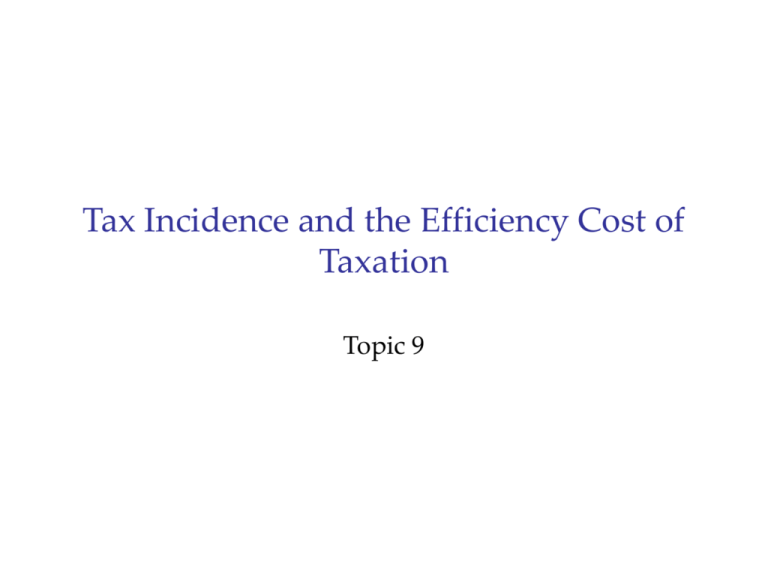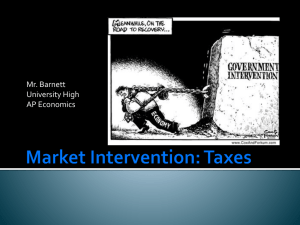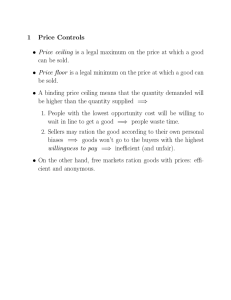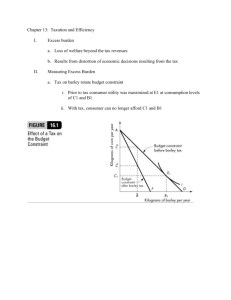Tax Incidence and the Efficiency Cost of Taxation
advertisement

Tax Incidence and the Efficiency Cost of Taxation Topic 9 Outline 1. The Economics of Taxation • The role of taxation. • The main types of taxation. Outline 1. The Economics of Taxation • The role of taxation. • The main types of taxation. 2. The Efficiency Cost of Taxation • Marginal excess burden. • Marginal cost of public funds. Outline 1. The Economics of Taxation • The role of taxation. • The main types of taxation. 2. The Efficiency Cost of Taxation • Marginal excess burden. • Marginal cost of public funds. 3. Tax Incidence • Formal and effective incidence. • Tax capitalisation. Outline 1. 2. 3. 4. The Economics of Taxation • The role of taxation. • The main types of taxation. The Efficiency Cost of Taxation • Marginal excess burden. • Marginal cost of public funds. Tax Incidence • Formal and effective incidence. • Tax capitalisation. Equity: Efficiency Trade offs in the design of the Tax System • The structure of income taxes. • Trade offs btwn equity and efficiency. • Income distribution and the structure of commodity taxes. 1. The Role of Taxation One potential classification of government functions – from an economic perspective would be • Efficiency – To reduce distortions in competition. – To alleviate the problems of incomplete markets 1. The Role of Taxation One potential classification of government functions – from an economic perspective would be • Efficiency – To reduce distortions in competition. – To alleviate the problems of incomplete markets • Equity – To provide merit goods – To alleviate poverty. 1. The Role of Taxation One potential classification of government functions – from an economic perspective would be • Efficiency – To reduce distortions in competition. – To alleviate the problems of incomplete markets • Equity – To provide merit goods – To alleviate poverty. • Stabilization (Macroeconomic Management) – To manage risks individuals face (insurance). – Macroeconomic stabilization Taxation has a role in each of these 1. Efficiency • Controls externalities. • Raises revenue for the provision of public goods. 2. Equity • Can redistribute income • Can generate revenues that provide other forms of poverty alleviation. 3. Stabilization • A key instrument in controlling aggregate demand • And the balance of trade Taxation and Politics Tax policy is highly politicised (an important election issue). Taxes signal societies values and approval/disapproval. Often there are intertemporal issues (balancing the budget today versus long term growth). Hidden taxes What are the criteria for a good tax system? 1. Fairness • Horizontal Equity • Vertical Equity What are the criteria for a good tax system? 1. Fairness • Horizontal Equity • Vertical Equity 2. Efficiency • Minimize the excess burden • Poll tax • Fiscal neutrality • The correction of externalities What are the criteria for a good tax system? 1. Fairness • Horizontal Equity • Vertical Equity 2. Efficiency • Minimize the excess burden • Poll tax • Fiscal neutrality • The correction of externalities 3. Compliance and Administration Costs • Compliance Costs = time, money inconvenience • Administration costs UK Fiscal Revenues 2003-04 = £407 bn Income Tax 122.1 30% UK Fiscal Revenues 2003-04 = £407 bn Income Tax Corporation Tax 122.1 30.8 30% 7.6% UK Fiscal Revenues 2003-04 = £407 bn Income Tax Corporation Tax National Insurance Other Inland Revenue 122.1 30.8 74.5 13.0 30% 7.6% 18.3% 3.2% UK Fiscal Revenues 2003-04 = £407 bn Income Tax Corporation Tax National Insurance Other Inland Revenue VAT Excise Duties – fuel - tobacco - alcohol Other Customs & Excise 122.1 30.8 74.5 13.0 66.6 23.0 8.0 7.4 7.8 30% 7.6% 18.3% 3.2% 16.4% 5.6% 2.0% 1.8% 1.9% UK Fiscal Revenues 2003-04 = £407 bn Income Tax Corporation Tax National Insurance Other Inland Revenue VAT Excise Duties – fuel - tobacco - alcohol Other Customs & Excise Business Rates Council Tax Vehicle Excise Duties Other 122.1 30.8 74.5 13.0 66.6 23.0 8.0 7.4 7.8 18.6 18.6 4.8 11.9 30% 7.6% 18.3% 3.2% 16.4% 5.6% 2.0% 1.8% 1.9% 4.6% 4.6% 1.2% 2.9% 2. The Efficiency Costs of Taxation Let us consider a Perfectly Competitive Market. In the Long Run we might treat supply as being a horizontal straight line. Equilibrium Before a Tax – P*Q* Demand Curve Price Supply Curve P* Q* Quantity Now Introduce a Tax Demand Curve Price Supply Curve including tax P** Tax Supply Curve P* Q** Q* Quantity Some Obvious Consequences 1. 2. 3. 4. Consumers are paying more for each unit. (bad) Government is earning taxes. (might be good) Consumers are buying fewer units. (bad) Firms are making fewer units. (Neutral here as perfect competition implies they make zero profit) How do these costs and benefits add up? Tax Revenue = Tax x Number of Units Demand Curve Price Supply Curve including tax P** Tax Revenue Supply Curve P* Q** Q* Quantity Tax Revenue = Exactly the losses of consumers who still buy Demand Curve Price Supply Curve including tax P** Extra Paid by Consumers Supply Curve P* Q** Q* Quantity This gain and loss exactly cancel The tax revenue = The extra paid by the consumers who still buy the taxed commodity. This is just a redistribution of income not an inefficiency. Summary: One effect of taxes is to transfer resources to the government. This reduces taxpayers’ disposable incomes. The Substitution Effect The price of this commodity has risen relative to other commodities. • This affects the incentives of the private sector. • It distorts markets. The Substitution Effect The price of this commodity has risen relative to other commodities. • This affects the incentives of the private sector. • It distorts markets. It generates “rents” A tax on tobacco makes growing it less attractive, therefore land prices fall. Tobacco machinery manufacturers lose as do tobacco workers. (Any input into a taxed commodity suffers.) This person was prepared to pay this much for the good. Demand Curve Price Supply Curve including tax P** Supply Curve P* Q** Q* Quantity Actually had to pay less. Demand Curve Price Supply Curve including tax P** Supply Curve P* Q** Q* Quantity But after the tax did not buy the good so this value was lost Demand Curve Price Supply Curve including tax P** Supply Curve P* Q** Q* Quantity Adding all these values then gives society’s total loss. Demand Curve Price Supply Curve including tax P** Supply Curve P* Q** Q* Quantity The Excess Burden This inefficiency is called “An Excess Burden” “A Deadweight Loss” The Excess Burden This inefficiency is called “An Excess Burden” “A Deadweight Loss” A poll tax (or any non-price related tax) will not have these costs. A US estimate has 20-30% of every $ raised generates this much extra burden. The Excess Burden Marginal Excess Burden := The excess burden of an extra £ raised in taxes. (This is generally higher than the average burden, as should tax least distorting commodities first.) The Excess Burden Marginal Excess Burden := The excess burden of an extra £ raised in taxes. (This is generally higher than the average burden, as should tax least distorting commodities first.) • A good tax system should impose taxes with least excess burden first. The Excess Burden Marginal Excess Burden := The excess burden of an extra £ raised in taxes. (This is generally higher than the average burden, as should tax least distorting commodities first.) • A good tax system should impose taxes with least excess burden first. • Then move on to those taxes with higher excess burden. The Excess Burden Marginal Excess Burden := The excess burden of an extra £ raised in taxes. (This is generally higher than the average burden, as should tax least distorting commodities first.) • A good tax system should impose taxes with least excess burden first. • Then move on to those taxes with higher excess burden. • Optimally, the marginal excess burden of each tax instrument should be the same. 3. Tax Incidence In other words – who bears the burden of taxes? 3. Tax Incidence In other words – who bears the burden of taxes? An important distinction: Formal Incidence: Who is legally obliged to pay the tax. Effective Incidence: Who actually bears the burden of the tax? 3. Tax Incidence In other words – who bears the burden of taxes? An important distinction: Formal Incidence: Who is legally obliged to pay the tax. Effective Incidence: Who actually bears the burden of the tax? These differ because prices can change as a result of a tax. Taxes On Business All taxes formally incident on business will have their final incidence on customers, shareholders and employees: Taxes On Business All taxes formally incident on business will have their final incidence on customers, shareholders and employees: Sales Taxes – Are Passed on and affect prices and customers also output and employees. Taxes On Business All taxes formally incident on business will have their final incidence on customers, shareholders and employees: Sales Taxes – Are Passed on and affect prices and customers also output and employees. Profits Tax – Affect shareholders and investment decisions (suppliers of capital). Taxes On Business All taxes formally incident on business will have their final incidence on customers, shareholders and employees: Sales Taxes – Are Passed on and affect prices and customers also output and employees. Profits Tax – Affect shareholders and investment decisions (suppliers of capital). Asset Taxes – Affect investment decisions. Effective Incidence is all that Matters to an Economist Who is legally obliged to pay a tax – is largely irrelevant if the taxed individuals can take actions to mitigate the effects the tax has. The Effect of a Sales Tax on a Market A market before a tax is imposed at equilibrium Price Q D Qs The Effect of a Sales Tax on a Market The tax raises the price paid by consumers. It lowers the price received by suppliers. Price Q D TAX Qs Why Does this Happen? Suppose the firms tried to raise their prices and pass on all the tax increase to the consumers, then: Why Does this Happen? Suppose the firms tried to raise their prices and pass on all the tax increase to the consumers, then: (1) The higher price for consumers would mean they would choose to buy less. Why Does this Happen? Suppose the firms tried to raise their prices and pass on all the tax increase to the consumers, then: (1) The higher price for consumers would mean they would choose to buy less. (2) However, the firms would still want to supply the same amount. Why Does this Happen? Suppose the firms tried to raise their prices and pass on all the tax increase to the consumers, then: (1) The higher price for consumers would mean they would choose to buy less. (2) However, the firms would still want to supply the same amount. (3) The market has Supply > Demand and prices will fall. Why Does this Happen? Suppose the firms tried to raise their prices and pass on all the tax increase to the consumers, then: (1) The higher price for consumers would mean they would choose to buy less. (2) However, the firms would still want to supply the same amount. (3) The market has Supply > Demand and prices will fall. (4) Thus prices for firms will fall until Supply(@Price less tax) = Demand (Price including tax) The Effect of a Sales Tax on a Market Notice also – less goods are produced. Some consumers don’t buy at the higher price. Some sellers don’t produce at the lower price. Price Q D Qs This reduces consumer surplus and producer surplus Q D P Lost consumer surplus Q s This reduces consumer surplus and producer surplus Q D Lost consumer surplus Q s P Lost producer surplus But generates tax revenue Q D P Q s Giving a net loss in value of ½ t xQ Q D P Q t DQ s WHO PAYS THE TAX? When buyers are price sensitive “demand is elastic” it is the sellers who pay the tax. WHO PAYS THE TAX? When buyers are price sensitive “demand is elastic” it is the sellers who pay the tax. WHO PAYS THE TAX? When buyers are price sensitive “demand is elastic” it is the sellers who pay the tax. Tax Incidence on Buyers WHO PAYS THE TAX? When buyers are price sensitive “demand is elastic” it is the sellers who pay the tax. Tax Incidence on Buyers Tax Incidence on Sellers WHO PAYS THE TAX? When sellers are price sensitive “supply is elastic” it is the buyers who pay the tax. Tax Incidence on Buyers Tax Incidence on Sellers Questions: Who pays the taxes on (1) (2) (3) (4) Cigarettes Alcohol Petrol Labour? Capitalization of Asset Taxes If you own an asset and there is a permanent change in the asset’s price that reflects its changed tax status. Capitalization of Asset Taxes If you own an asset and there is a permanent change in the asset’s price that reflects its changed tax status. When the owner of the asset comes to sell it they get an increased/decreased price that reflects its changed tax status. Say “Tax changes have been capitalized” Capitalization of Asset Taxes If you own an asset and there is a permanent change in the asset’s price that reflects its changed tax status. When the owner of the asset comes to sell it they get an increased/decreased price that reflects its changed tax status. Say “Tax changes have been capitalized” Any subsequent owner receives no benefits/costs of the taxes. Example Land gets taxed: 1. When you come to sell your land, it is of reduced value because of its tax liability. Example Land gets taxed: 1. When you come to sell your land, it is of reduced value because of its tax liability. 2. The price of land falls to include the total cost of the taxes you must pay on it. Example Land gets taxed: 1. When you come to sell your land, it is of reduced value because of its tax liability. 2. The price of land falls to include the total cost of the taxes you must pay on it. 3. Buyers will pay less. Example Land gets taxed: 1. When you come to sell your land, it is of reduced value because of its tax liability. 2. The price of land falls to include the total cost of the taxes you must pay on it. 3. Buyers will pay less. 4. Only the initial owner pays the tax. 5. There is a reduction of taxes on housing. Only the owners at the time benefit. They gain twice (1) lower current taxes (2) higher eventual sale price. Policy Implications One off asset tax increases have very big costs to current owners. Even announcing a tax change is important as it will affect asset prices – even if the tax change does not eventually occur. 4. Taxation and Equity IF policy makes care about equity they will care about the winners and losers associated with tax changes. Recall A tax is progressive if payment as a % of income increases as income rises. A tax is regressive if payment as a % of income decreases as income rises. A tax is neutral if payment as a % of income constant as income rises. Distributional Effects of Taxes We can assess the distributional effects of one tax or of the tax system as a whole. • The overall incidence is more important than the effects of single taxes. • But introducing progressive taxes may improve a regressive system. • Remember it is still important to focus on the economic incidence of taxes not the formal incidence. Marginal versus Average Tax Rates There are 2 distinct ways of achieving progressive tax systems: (1) Raise the marginal rate of taxes at higher income levels. Marginal versus Average Tax Rates There are 2 distinct ways of achieving progressive tax systems: (1) Raise the marginal rate of taxes at higher income levels. (2) Allow some income to not be liable for taxes (a taxfree allowance). Increasing marginal rates Example: 25% for first £30k and 50% tax rate thereafter. Marginal Tax Rate 50% 25% Income Average Rate Example Continued You earn £50k Your tax bill = £30k x 0.25 = £7,500 Plus = £10,000 = £17,500 (£50k-£30k) x 0.50 Tax Rate = 17500/50000 = 35% Tax Free Allowance Example: 0% for first £10k and 25% tax rate thereafter. Marginal Tax Rate 25% Income Average Rate Can Achieve Progressive Sales Taxes Tax luxuries more highly than necessities. UK ( Children’s clothing, water, food, public transport). Note the well paid also benefit a lot from these taxes (food). They spend more on food – but it is a small chare in their budget.









